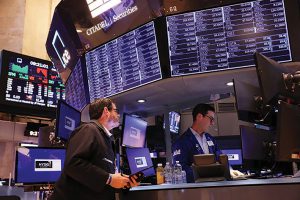Jonathan Levin
The latest bear-market rally in US stocks has brought investors off the sidelines and provided a welcome reprieve from three quarters of gloom. But traders now need to ask themselves whether the risks continue to justify the potential returns.
The S&P 500 Index has rallied 7.9% since October 12, helped by hardy corporate earnings, stabilizing US Treasury yields and a sense that the sell-off had gone too far. The rally was widely predicted, most prominently by Morgan Stanley strategist Mike Wilson, who characterized it at the time as a “tactical†call, not a sign of a fundamental turning point in the outlook for equities.
Of course, the market is passing through a transition period. Stock valuations have undergone a long period of adjustment to higher interest rates this year, but prices still don’t reflect the sorts of earnings declines expected in a typical recession. That’s in part because the hard economic data and corporate earnings haven’t yet confirmed the bearish forecasts of a growing number of economists. The bear market is experiencing something of an interlude, which has opened the door for short-term speculation.
At the same time, there’s a hard cap on how high stocks can go as long as the Federal Reserve is on the warpath. Monetary policymakers have expressed broad commitment to bringing down the highest inflation in 40 years, and that means higher interest rates and generally tighter financial conditions. If bond yields fall and stock prices rise, the Fed will simply ratchet up its hawkish rhetoric to bring them back in line.
Traders now have to ask themselves whether they’re truly nimble enough to chase this latest short-term rally to culmination without toppling off the inevitable cliff at the end of it. Morgan Stanley’s Wilson has said that the rally could run to 4,000-4,150 (another 3.7% to 7.5% from the current level of 3,859.11) That makes some sense: A couple of key technical indicators suggest that 4,000 is an important level. 1 At this rate, maybe the index even hits 4,000 this week. But after that, the risk-reward calculation could deteriorate swiftly. Consider the multitude of perils ahead:
Any one of these risk events could certainly swing positive or negative, but the closer the market drifts to the Fed’s implicit ceiling, the worse the risk-reward equation looks heading into that roller coaster six-day period. Stock traders have had some well-deserved fun in the past couple weeks, but they might have to think about getting serious again before the start of November.
—Bloomberg
 The Gulf Time Newspaper One of the finest business newspapers in the UAE brought to you by our professional writers and editors.
The Gulf Time Newspaper One of the finest business newspapers in the UAE brought to you by our professional writers and editors.
